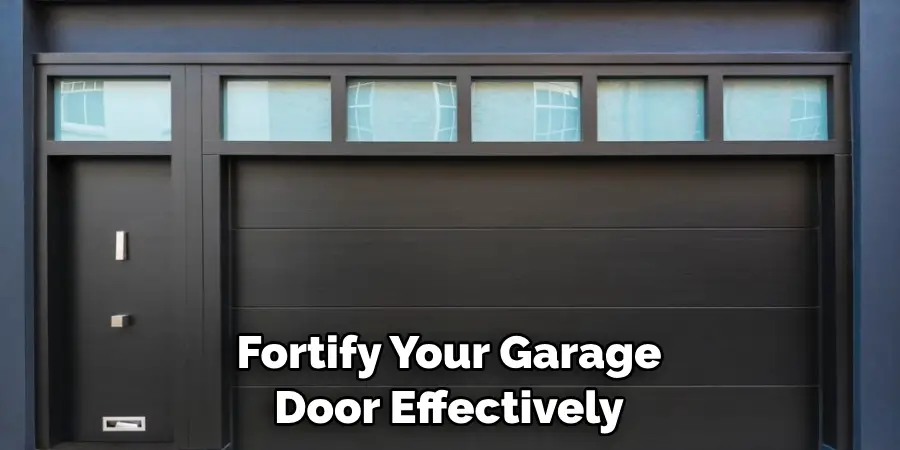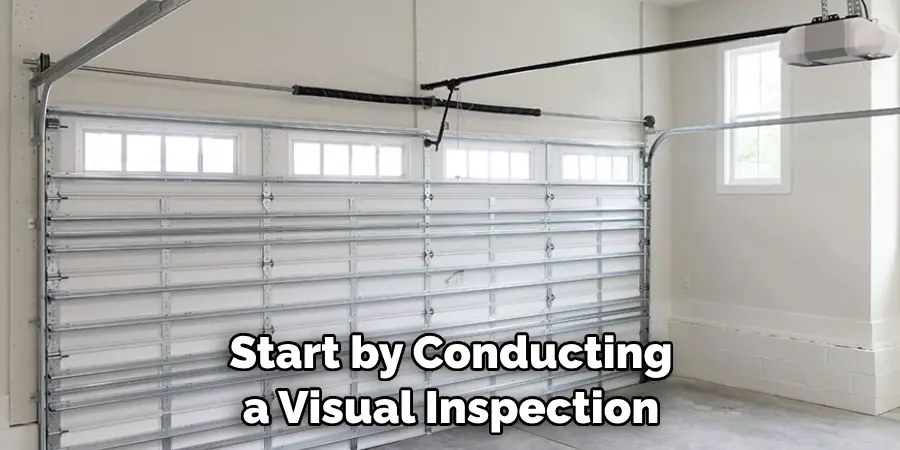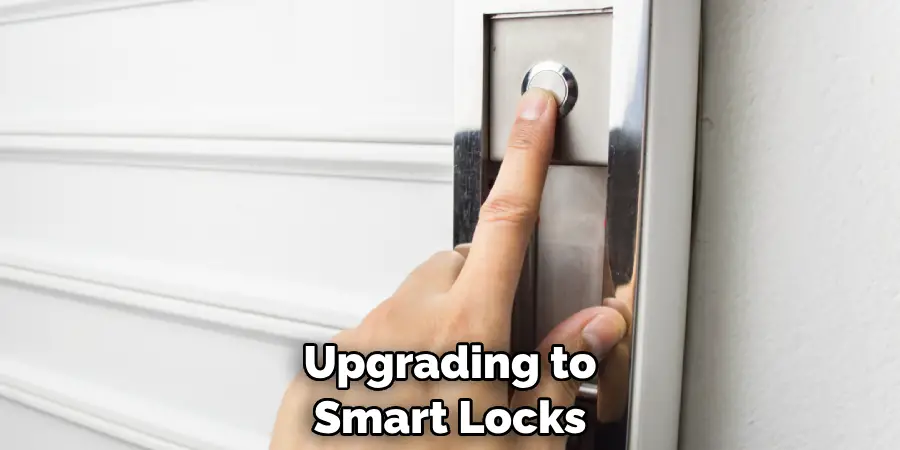Securing your garage door is essential for protecting your home and belongings from potential intruders and adverse weather conditions. Reinforcing your garage door not only enhances its strength and durability but also provides added peace of mind.

In this guide, we’ll explore various methods and strategies for how to reinforce garage door. From reinforcing the door panels with sturdy materials to installing additional locking mechanisms and security features, each step plays a crucial role in fortifying your garage against potential threats.
Whether you’re looking to upgrade an existing garage door or bolster the security of a new installation, understanding how to reinforce your garage door properly is essential for safeguarding your property and ensuring the safety of your loved ones.
Importance of Reinforcing Garage Doors for Security
The importance of reinforcing garage doors for security purposes cannot be overstated. Garages often serve as a primary entry point to a home, making them a target for burglars and intruders seeking easy access.
An inadequately secured garage door not only poses a risk to the valuables stored within, such as vehicles, tools, and other personal belongings but also potentially offers an entryway into your home, compromising the safety of its occupants.
Furthermore, in areas prone to severe weather, a reinforced garage door plays a critical role in preventing damage from storms, hurricanes, or high winds, which could otherwise result in costly repairs. By investing in the reinforcement of garage doors, homeowners can significantly enhance their home’s security, deter would-be intruders, and protect their property against environmental damage.
Benefits of A Reinforced Garage Door
Reinforcing a garage door comes with a plethora of benefits that extend beyond mere security enhancements. Firstly, a reinforced door significantly increases the structural integrity of the garage, making it more resistant to physical damage from external forces such as severe weather conditions or accidental impacts.
This durability ensures the longevity of the door, ultimately saving homeowners money on replacements and repairs in the long run. Additionally, a well-fortified garage door can improve the insulation of the garage space, leading to better energy efficiency.

This not only keeps the garage at a more consistent temperature but can also reduce energy costs by limiting the transfer of heat and cold between the garage and the outside environment. Furthermore, a reinforced garage door can contribute to the overall aesthetic appeal and value of the property.
Modern reinforcement options are designed to complement the appearance of the garage and home, boosting curb appeal. Lastly, the peace of mind that comes with knowing your home is more secure and protected against both intruders and environmental threats is an invaluable benefit that reinforces the importance of investing in a reinforced garage door.
Assessing Your Garage Door’s Vulnerabilities
Before you can effectively reinforce your garage door, it’s crucial to assess its current vulnerabilities. This evaluation will enable you to identify the areas that require immediate attention and determine the most effective reinforcement strategies.
Firstly, inspect the door panels for any signs of wear, damage, or weakness, as these can be easily compromised by external forces. Secondly, examine the door’s frame and hinges, which should be sturdy and free from rust or corrosion, to ensure they can support the weight of the door without failing.
Additionally, consider the type of locking mechanism currently in use; a weak or outdated lock can be an easy target for intruders. Assessing the garage door opener and its security features is also vital; advanced models often come with additional security measures that older models lack.
Lastly, do not overlook the importance of the surrounding structure, including the walls and the garage door’s seal. Any gaps or weaknesses in these areas can be exploited not only by intruders but also by severe weather conditions.
By thoroughly examining these key aspects, homeowners can accurately identify their garage door’s vulnerabilities and take the necessary steps to enhance its security and durability.
Identifying Weak Points and Potential Entry Areas
To fortify your garage door effectively, it’s crucial to identify potential weak points and entry areas that could be exploited by intruders or compromised in adverse weather conditions. These vulnerabilities often serve as the initial targets for burglars and can also be the first to fail under the strain of environmental forces. Key areas to focus on include:

- Door Panels: Check for dents, warping, or any form of structural weakness. Panels that are not solid or have visible damage can easily be breached or broken.
- Windows: If your garage door has windows, they represent a potential entry point for intruders. Assess their security, looking for any cracks or weak framing that could be exploited.
- Locks and Latches: Evaluate the condition and strength of all locks and latches. Older or basic lock mechanisms are more susceptible to being picked or forced open.
- Hinges and Hardware: Inspect the hinges and other hardware for signs of wear or damage. Rust and corrosion can weaken these components, making the door easier to manipulate or remove.
- Garage Door Opener: Consider the age and model of your garage door opener. Outdated models may lack modern security features, making it easier for burglars to hack or bypass.
- Weather Seals: Examine the seals around the garage door. Gaps or damage to the weatherstripping can not only lead to energy loss but also provide small entry points for tools used in break-ins.
- Door Tracks and Rollers: Inspect the tracks and rollers for any misalignment, bending, or obstruction that could prevent the door from closing fully or securely.
By meticulously identifying and addressing these potential weak points, homeowners can significantly improve their garage door’s resistance to intrusion and environmental damage, ensuring a higher level of security and peace of mind.
Assessing the Current Condition of the Garage Door
To ensure your garage door operates efficiently and offers the highest level of protection, a comprehensive assessment of its current condition is essential. This assessment involves a detailed inspection to identify signs of wear, potential vulnerabilities, and areas needing immediate attention or future monitoring.
Start by conducting a visual inspection of the entire door and its components, looking for any visible signs of damage such as rust, dents, or wear on the door panels, tracks, and hardware. Listen for unusual noises when the door operates, as these can indicate problems with the rollers, tracks, or opener mechanism.

It’s also important to check the balance of the door by manually lifting it halfway; a door in good condition should stay in place, indicating well-adjusted springs.
Additionally, test the responsiveness of the opener and the efficiency of the safety features, such as the auto-reverse mechanism. Evaluating the insulation and checking the integrity of the weather seals around the door are crucial steps to determine the garage’s energy efficiency and protection against weather elements.
By thoroughly assessing these aspects, homeowners can develop a clear understanding of their garage door’s condition, identify necessary repairs or upgrades, and take proactive steps to enhance security and functionality.
10 Methods How to Reinforce Garage Door
1. Upgrade to a Reinforced Garage Door:
Consider replacing your existing garage door with a reinforced model designed to withstand higher levels of impact and force. Reinforced garage doors are typically constructed with durable materials such as steel or fiberglass and feature additional reinforcements in key areas to enhance strength and security.
These types of doors are especially beneficial for areas prone to extreme weather conditions or high levels of crime.
2. Install Reinforcement Brackets:
Reinforcement brackets can be installed on the inside of your garage door to provide additional support and stability. These brackets are typically made of heavy-duty steel and are attached to the door panels and tracks, helping to prevent the door from bending or warping under pressure.
This is especially useful for larger and heavier doors, such as those made of wood or metal. While they can be installed on both manual and automatic doors, they are especially important for automatic garage doors due to the added weight of the motor and opener.
3. Add a Garage Door Strut:
Garage door struts are horizontal braces that run across the inside of the door panels, providing extra reinforcement and support. Installing a garage door strut can help distribute the weight of the door more evenly and reduce stress on the panels, particularly in larger garage doors.

Additionally, garage door struts can also prevent the door from sagging or warping over time.
4. Upgrade to High-Quality Hardware:
Replace your garage door’s hardware, such as hinges, rollers, and tracks, with high-quality, heavy-duty options. Upgrading to robust hardware can improve the overall performance and durability of your garage door, making it more resistant to forced entry and wear and tear over time.
Additionally, high-quality hardware can also enhance the overall appearance of your garage door, giving it a more polished and professional look.
Hardware is an essential component of any garage door. It is responsible for supporting the weight of the door and ensuring smooth operation.
However, over time, hardware components can wear out due to constant use and exposure to weather conditions. This can result in malfunctions and potential safety hazards. Upgrading to high-quality hardware can help prevent these issues and keep your garage door functioning properly.
5. Install a Garage Door Defender:
A garage door defender is a metal bar or rod that can be installed across the inside of the garage door tracks to prevent the door from being forced open. This simple yet effective device provides an additional layer of security and can deter intruders from attempting to breach your garage. In this guide, we will discuss the steps you need to follow in order to install a garage door defender.
6. Reinforce the Door Tracks:
Inspect the garage door tracks for any signs of damage or wear and reinforce them as needed. This may involve tightening loose bolts, lubricating moving parts, or replacing damaged sections of the track to ensure smooth and secure operation.
You may also want to consider installing additional support brackets or braces for added strength. While this may seem like a small task, it can greatly improve the overall stability and longevity of your garage door.
7. Add Security Grilles or Screens:
Install security grilles or screens over your garage door windows to prevent intruders from gaining access through them. These grilles are typically made of durable metal and can be customized to match the aesthetic of your home while providing an added layer of protection against forced entry.

In addition to preventing break-ins, security grilles or screens can also act as a deterrent for potential burglars. The presence of these barriers sends a message that your home is well-protected and not an easy target.
When choosing security grilles or screens, make sure they are sturdy and securely attached to the window frame. You may also want to consider models with tamper-resistant locks for added security.
8. Upgrade to a Smart Garage Door Opener:
Consider upgrading to a smart garage door opener that offers advanced security features such as remote monitoring, automatic locking, and smartphone integration. Smart garage door openers allow you to control and monitor your garage door from anywhere, providing peace of mind and enhancing security. However, before making the switch, there are a few things to consider.
9. Secure Garage Door Emergency Release:
The emergency release mechanism on your garage door can be a potential weak point for intruders. Install a garage door emergency release shield or lock to prevent unauthorized access to the release mechanism from the outside, while still allowing for easy operation from the inside in case of emergencies.
Additionally, teach your family members about the importance of keeping this release mechanism secure and not sharing its location or operation with anyone outside the household.
10. Maintain Regular Inspections and Maintenance:
Finally, regularly inspect and maintain your garage door to ensure that it remains in optimal condition. This includes lubricating moving parts, tightening hardware, checking for signs of wear or damage, and addressing any issues promptly to prevent them from escalating into larger problems.
It is recommended to have a professional inspection at least once a year to catch and fix any potential issues early on.
Additional Tips for Enhanced Security
To further bolster the security of your garage and, by extension, your entire home, consider implementing advanced security measures. Installing a security camera aimed at your garage door can deter potential intruders and provide valuable footage in the event of a break-in.

Additionally, integrating your garage door with a smart home security system allows you to monitor and control it remotely, ensuring peace of mind no matter where you are. For added security, regularly update any electronic codes associated with your garage door opener and avoid sharing them broadly. These proactive steps can significantly enhance your garage’s defense against unauthorized access.
Regular Maintenance and Inspection of The Garage Door
Regular maintenance and inspection play pivotal roles in the longevity and reliability of your garage door. A well-maintained garage door not only functions more smoothly but also poses fewer safety risks to users. During routine inspections, look for common issues such as uneven hanging, strange noises, or slow response times, which could indicate more serious problems.
Regularly cleaning tracks and lubricating rollers, springs, and hinges can prevent rust and ensure smooth operation. It’s important to replace worn-out weather stripping to keep your garage dry and protected from the elements. By dedicating time to these maintenance tasks, you can extend the life of your garage door, enhance its functionality, and maintain the security of your home.
Reinforcing Windows and Other Potential Entry Points
Reinforcing windows and other potential entry points is a crucial step in enhancing your garage’s security. Windows, often overlooked, can provide easy access for intruders if not properly secured. Consider installing window locks or security film to strengthen the glass against break-ins.
For added protection, bars or metal grates can be mounted, though they should comply with local fire safety regulations to ensure they do not block emergency exits. Additionally, inspect any side or back doors leading into the garage. These doors should be solid, without windows, and equipped with high-quality deadbolts.
Upgrading to smart locks can also offer an extra layer of security by allowing you to monitor and control access remotely. By securing these potential entry points, you significantly reduce the risk of unauthorized access to your garage and home.

Conclusion
In conclusion, reinforcing your garage door is a crucial step in enhancing the security of your home and safeguarding your belongings. By following the comprehensive guide outlined in this article, homeowners can effectively address vulnerabilities and deter potential intruders.
Taking proactive measures such as securing hinges and tracks, installing reinforcement kits, and implementing additional security features like locks and alarms can significantly strengthen the overall security of your garage. It’s important to remain vigilant and regularly inspect and maintain your garage door to ensure continued effectiveness.
Thanks for reading, and we hope this has given you some inspiration on how to reinforce garage door!

